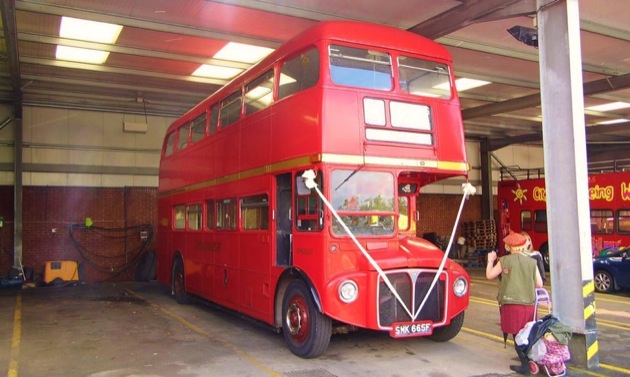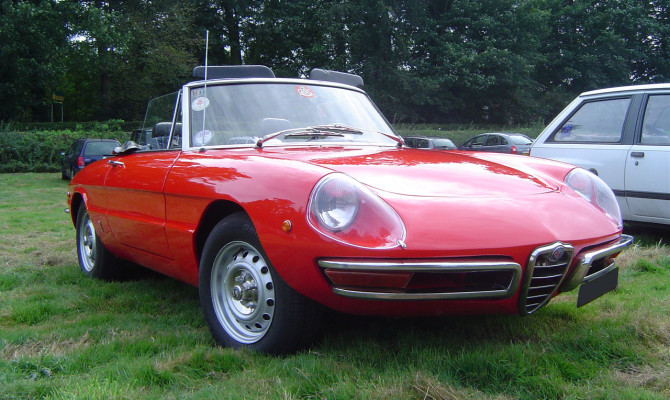
Dubbed “The Greatest Show on British Wheels,” the Vancouver All British Field Meet (ABFM) will host more than 500 classic British-built vehicles and motorcycles on the Great Lawn of the world renowned VanDusen Botanical Garden, while celebrating its 31st year, on Saturday May 21, 2016.
For more info see: http://bit.ly/1EDXTJY
Photo: Cam Hutchins
By John Mayhead
For those of us who also love automobiles, the best romantic films are those that feature an interesting car or two.
Pretty Woman – 1989 Lotus Esprit SE
Richard Gere’s high-flying businessman Edward was bound to own an exotic “foreign” classic, but when both Ferrari and Porsche declined to be associated with a film linked to prostitution, Lotus stepped in. The gamble paid off and sales of the Esprit (actually a modified 1990 model SE).
Notting Hill – 1967 Park Royal AEC Routemaster Bus
OK, so it’s not exactly a star in the film, but we love the old Routemaster, brought into service in 1967 by London Transport, and now available for weddings and special events!
When Harry Met Sally – 1976 Toyota Corona Station Wagon (Estate)
Meg Ryan’s character Sally drove the least-exciting car on our list. The RT119 Toyota Corona had the 2.2-litre 20R engine, that generated a modest 96 hp.
The Graduate – 1966 Alfa Romeo Duetto Spider
When a young Dustin Hoffman was cast as Benjamin Braddock, his uncle offered to supply the character’s car. The uncle was the legendary U.S. car importer Max Hoffman, and the car was the newly released Alfa Romeo Duetto Spider.
Dirty Dancing – 1957 Chevrolet Bel Air
Patrick Swayze’s character Johnny Castle drove one of the most iconic American cars of all time in Dirty Dancing – the 1957 Chevrolet Bel Air 2-door hardtop.
Love Actually – 1992 Saab 900 XS
Colin Firth’s character Jamie famously learned Portuguese in order to woo his housekeeper, but we all know it was his Saab 900 that really attracted Aurelia, played by Lucia Moniz.
The Love Bug – 1963 Volkswagen Beetle
With his big personality and amazing speed, Herbie cemented the VW Beetle as an iconic car. Ironically, Volkswagen did not support Disney’s use of the car, and as a result, all VW badges and logos were removed.
The Notebook – 1946 Hudson Commodore
Through the tears, you may be able to spot the 1946 Hudson Commodore Eight Club Coupe driven by Rachel McAdams’ character.
Bridget Jones’s Diary – 1969 Mercedes-Benz 280SE Convertible
Hugh Grant’s smooth-talking Daniel Cleaver had the coolest car. His 1969 Mercedes-Benz 280SE Convertible in blue has the 2778cc inline-6 M130 engine and is an earlier “high grille” car.
True Romance – 1988 Porsche 911 Flachbau Cabriolet
The white Porsche 911 Flachbau (Flat Nose) cabriolet was perfectly cast – it was ostentatious, noisy and flashy, matching Elliott Blitzer’s character as a movie executive and aspiring actor.
John Mayhead writes for Hagerty Insurance. Hagerty is the world’s leading specialist provider of classic car and boat insurance. Learn more at hagerty.ca.
By Jonathan A. Stein
With almost 400,000 MGBs built over the course of 18 years, you’d think that there would be very little left that the entire world didn’t know about MG’s most prolific model.
Of course, there’s no secret when it comes to the engine, transmission and suspension, which were heavily based on those of the MGA. And, it’s equally well known that unlike the MGA, the MGB used unibody construction. But here are a few things you probably didn’t know.
One of the reasons the engine bay of the MGB was so wide was to accommodate the Twin Cam cylinder head of the MGA Twin Cam. But many development and reliability problems sent BMC scurrying away from the powerful but problematic engine.
The MGA coupe works development car, registered KMO 326, served as a high-speed test bed for the MGB’s revised front suspension and disc brakes. A disproportionate number of early MGBs destined for North America were finished in Iris blue, a light blue shade carried over from the MGA.
Although the MGB/GT design was prepared by Pininfarina, the original concept for the car came from MG General Manager John Thornley, who conceived the fastback as a poor man’s Aston Martin.
Although North American-bound MGBs received a new padded dashboard without a glove box beginning with the 1968 model year, UK market cars continued on with the less-yielding metal dashboard.
There are plenty other little bits of trivia about the MGB that might not necessarily be considered secrets.
For the North American market, 1969 was the first year of reclining seats and the last year of leather seating surfaces. In 1973 and 1974, U.S. market B/GTs received fabric upholstery, while roadsters used vinyl. And of course there were those unsightly rubber bumpers that were introduced in mid-year 1974 as the most expedient way to meet new 5-mph crash regulations.
The solution to meeting the new federal headlight requirement was even less elegant: raise the ride height until the lights were legal. It didn’t do much for the handling, but the car continued to sell until the bitter end in 1980.
Jonathan Stein writes for Hagerty Insurance. Hagerty is the world’s leading specialist provider of classic car and boat insurance. Learn more at hagerty.ca.
Recent Comments
- { Enjoyed your Forest of Bowland in the BMW X5M, particularly the photo of the BMW in front of the main part of Stonyhurst College where... }
- { Bantam designed the Jeep, not Willy's or Ford. The American military gave the original Bantam prototype to Willys and Ford to copy. There is plenty... }
- { All Escalades come with a 6.2-lilter V8 engine that produces 420 horsepower. A six-speed automatic is the only transmission offered and drives the rear wheels.... }
- { Alexandra is an excellent journalist. }
Popular Posts
- Journey to a ‘Sparkling’ Luxury Okanagan Resort “Four lucky readers will put a Dodge Journey’s weekend-...
- The Need For Speed: Hike Those Highway Limits More than half of those polled believe the province sho...
- Drives-U-Crazy… Erratic drivers. An early morning drive from Kelowna to Vancouver is nor...
- Readers Respond: The Pros and Cons of Increasing B.C. Speed Limits Increasing the speed limits will only increase risk to...
- Honda CR-V Review: The Compact Crossover To Get Things Done The CRV is a very stylish and aerodynamic crossover veh...















